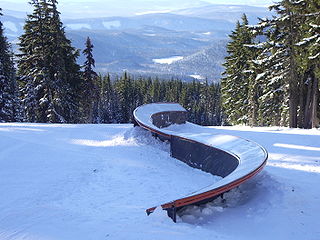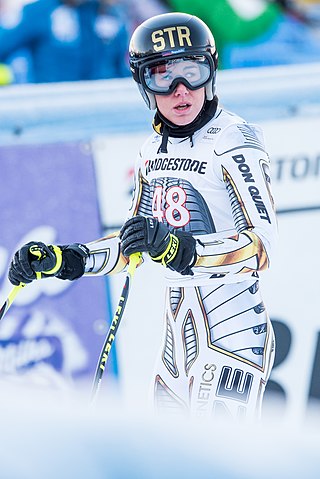
Skiing is the use of skis to glide on snow. Variations of purpose include basic transport, a recreational activity, or a competitive winter sport. Many types of competitive skiing events are recognized by the International Olympic Committee (IOC), and the International Ski and Snowboard Federation (FIS).

Winter sports or winter activities are competitive sports or non-competitive recreational activities which are played on snow or ice. Most are variations of skiing, ice skating and sledding. Traditionally, such games were only played in cold areas during winter, but artificial snow and artificial ice allow more flexibility. Playing areas and fields consist of either snow or ice.

The following outline is provided as an overview of and topical guide to skiing:
Nordiq Canada is the governing federation for cross-country skiing in Canada.
The Canadian Snowboard Federation is the governing body in Canada for the sport of snowboarding. It is a member discipline of the Canadian Snowsports Association, and is recognized by the Government of Canada, the Fédération Internationale de Ski, the World Snowboard Federation, the Canadian Olympic Committee, and the Canadian Paralympic Committee. They are a federally incorporated non-profit organization. Canada~Snowboard is governed by a board of directors elected by and from its volunteer membership and manages programs nationally and locally through professional staff, provincial and territorial snowboard associations, and their affiliated clubs.
Ski Jumping Canada is the governing federation for ski jumping in Canada. It is responsible for the governance of all ski jumping competitions in Canada and for the operation of the national team. Canada has competed in ski jumping at the Winter Olympics since 1928.
LW12 is a para-alpine and para-Nordic sit skiing sport class defined by the International Paralympic Committee (IPC). An LW12 skier needs to meet a minimum of one of several conditions including a single below knee but above ankle amputation, monoplegia that exhibits similar to below knee amputation, legs of different length where there is at least a 7 centimetres difference, combined muscle strength in the lower extremities less than 71. For international competitions, classification is done through IPC Alpine Skiing or IPC Nordic Skiing. For sub-international competitions, classification is done by a national federation such as Alpine Canada. For para-alpine, this class is subdivided into two subclasses.: LW12.1 and LW12.2. A new sit-skier competitor with only national classification will compete as LW12.2 in international competitions until they have been internationally classified.

LW11 is a para-alpine and para-Nordic sit skiing sport class, a classification defined by the International Paralympic Committee (IPC for people with paralysis in the lower extremities and people with cerebral palsy that affects the lower half of the body. Outside of skiing, the competitor in this class is unable to walk. For international competitions, classification is done through IPC Alpine Skiing or IPC Nordic Skiing. For sub-international competitions, classification is done by a national federation such as Alpine Canada.

LW10 is a para-alpine and para-Nordic sit-skiing classification for skiers who cannot sit up without support. For international skiing competitions, classification is conducted by IPC Alpine Skiing and IPC Nordic Skiing, while national federations such as Alpine Canada handle classification for domestic competitions.

LW2 is a para-alpine and para-Nordic standing ski sport class defined by the International Paralympic Committee (IPC). Competitors in this class have severe disability in a lower limb, which may be a result of an amputation, or arthrodesis in the leg and hip. Depending on the type of skiing, the international classification process for LW2 skiers is handled by the IPC Alpine Skiing Technical Committee and IPC Nordic Skiing Technical Committee. National sport federations handle classification on the lower levels.
LW3 is a para-alpine and para-Nordic standing skiing sport class defined by the International Paralympic Committee (IPC) for skiers with a disability affecting both legs, with double below knee amputation or a combined strength total for both legs of 60, with 80 as the baseline for people without disabilities. For international skiing competitions, classification is done through IPC Alpine Skiing or IPC Nordic Skiing. The classification has two subclasses for para-alpine skiing: LW3.1 which is for people with double below the knee amputations or similar disabilities, and LW3.2 which is for people with cerebral palsy that involves moderate athetoid, moderate ataxic impairment or slight diplegic involvement.
LW4 is a para-alpine and para-Nordic standing skiing sport class defined by the International Paralympic Committee (IPC) for skiers who may have a disability in one lower extremity, which may be a result of a leg amputation below the knee, knee arthrodesis or a hip arthrodesis. For international skiing competitions, classification is done through IPC Alpine Skiing or IPC Nordic Skiing. A national federation such as Alpine Canada handles classification for domestic competitions.
LW5/7 is a standing para-alpine and para-Nordic skiing classification for skiers with upper extremity issues in both limbs that may include double amputation of both arms and hands or dysmelia of the upper limbs. The class has three subclasses defined by the location of the disability on the upper extremities. International classification is done by IPC Alpine Skiing and IPC Nordic Skiing. On the national level, classification is handled by national sports federation such as Cross-Country Canada.

LW6/8 is a para-alpine and para-Nordic standing skiing sport class, a classification defined by the International Paralympic Committee (IPC) for people with an upper extremity issue who have paralysis, motor paresis affecting one arm, a single upper arm amputation or CP8 classified cerebral palsy. LW6/8 skiers use two skis and one pole in both para-alpine and para-Nordic skiing.
LW9 is a para-alpine and para-Nordic standing skiing sport class, a classification defined by the International Paralympic Committee (IPC) for people with upper and lower limb function problems, and includes cerebral palsy skiers classified CP5, CP6 and CP7, along with people with hemiplegia or amputations. For international skiing competitions, classification is done through IPC Alpine Skiing or IPC Nordic Skiing. A national federation such as Alpine Canada handles classification for domestic competitions. This classification is separated into two subclasses including LW9.1 and LW9.2.

Ester Ledecká is a Czech snowboarder and alpine skier. At the 2018 Winter Olympics in Pyeongchang, Ledecká won gold medals in the super-G in alpine skiing and in the parallel giant slalom in snowboarding, becoming the first person to not only compete in the Winter Olympics using two different types of equipment but to go further and win two gold medals and do so at the same Winter Olympics. She was the second woman to win an Olympic gold in two separate disciplines but the first to do so at the same Winter Olympics. She was the first Czech to win the parallel giant slalom in snowboarding at the FIS Snowboard World Cup.
From August 22, 2012 to March 27, 2013, the following skiing events took place at various locations around the world.

Mikayla Martin was a Canadian alpine skiing, ski cross and mountain bike athlete holding multiple titles in both mountain biking and skiing racing. She raced with the British Columbia Alpine Ski Team from 2014 to 2017 and the Canadian Ski Cross Team from 2017 to 2019. Martin placed 4th in the 2017 Canadian National Championships and won gold at the 2018 World Junior Ski Cross Championships in Cardrona, New Zealand. She was promoted to the Canada Ski Cross World Cup team for the 2018-2019 season and at her first World Cup race in Arosa, Switzerland on Dec 16, 2018, she qualified third and finished 9th after failing to advance to the semi-finals. At her second World Cup race in Innichen, Italy on Dec 22, 2018 she finished 6th and qualified for the 2019 FIS Ski and Snowboard World Championships in Park City, Utah. At the 2019 World Championships, Martin finished 8th but was unable to start the small final due to an injury in the semi-finals that required medical attention.FIS Freestyle Ski and Snowboarding World Championships 2019.

Canada competed at the 2022 Winter Paralympics in Beijing, China which took place between 4–13 March 2022.
The FIS Games is an international multi-sport event organized and centered around the disciplines governed by the International Ski and Snowboard Federation. Held once every four years, the 16-day event will debut in 2028.










